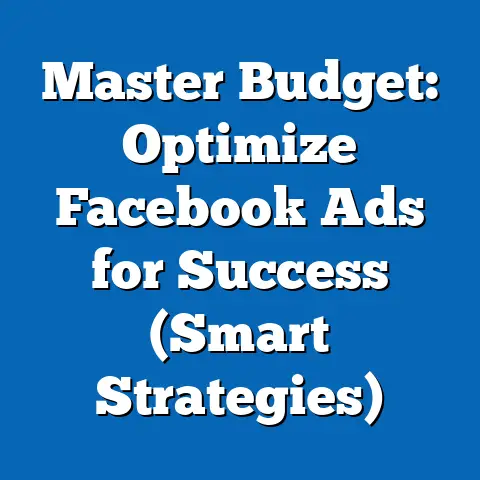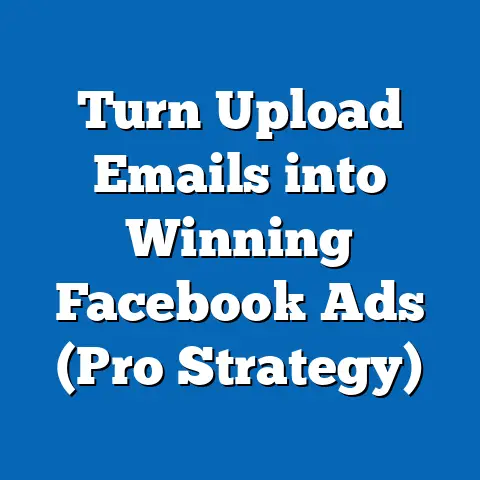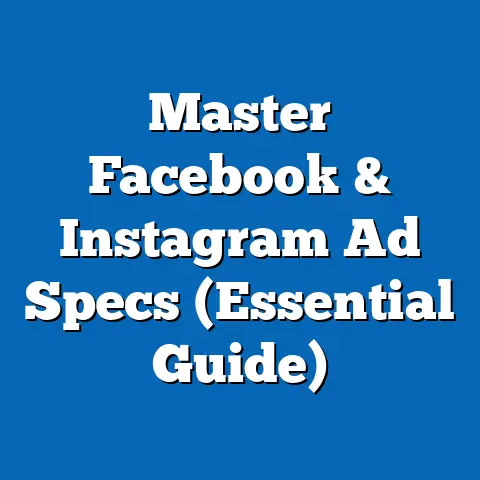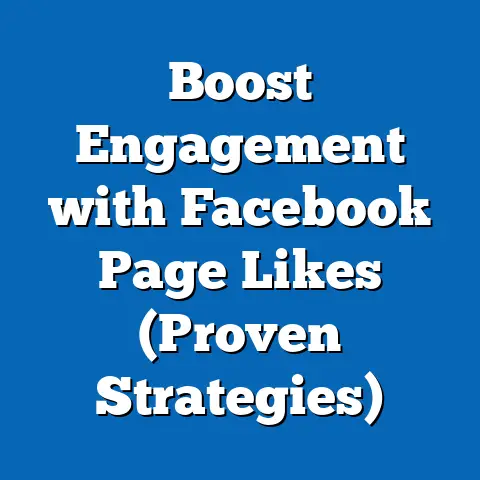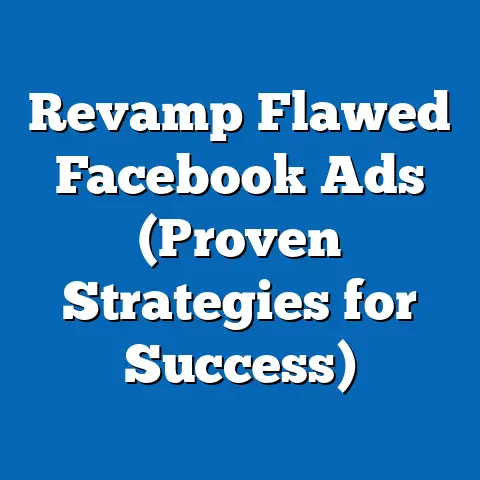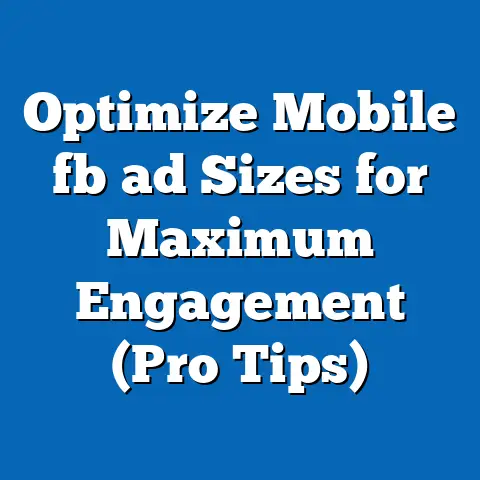Maximize fb ad Success with the Right Search Tool (Pro Tips)
In the dynamic world of digital marketing, standing still is the same as falling behind. The landscape is ever-evolving, and nowhere is this more evident than in the realm of Facebook advertising. Consumer behavior shifts with the tides, Facebook’s algorithms are a constant puzzle, and what worked yesterday might be obsolete tomorrow. As a digital marketing specialist, I’ve seen countless businesses struggle to keep up, and honestly, I’ve had my own fair share of head-scratching moments. That’s why adaptability isn’t just a buzzword; it’s the lifeblood of a successful Facebook ad strategy.
The key to navigating this ever-changing environment? Embracing the power of search tools. I’m not just talking about basic keyword research; I’m referring to a comprehensive approach that leverages data-driven insights to manage, analyze, and optimize your Facebook ad campaigns for maximum impact.
Think of it this way: you wouldn’t go on a cross-country road trip without a map, would you? Search tools are the GPS for your Facebook ad journey, guiding you through the complexities of targeting, creative optimization, and performance tracking. They provide invaluable data on keywords, competitor strategies, audience behavior, and much more.
In this article, I’m going to share some pro tips that I’ve learned over the years, helping you harness the power of search tools to supercharge your Facebook ad campaigns. We’ll cover everything from keyword research to competitor analysis, audience insights to ad copy optimization, and performance tracking to strategic adjustments.
Get ready to dive deep into the world of Facebook advertising, armed with the knowledge and tools you need to thrive in this competitive landscape. Let’s get started!
Understanding Facebook Ads
Facebook ads have become a cornerstone of the digital marketing ecosystem. With billions of active users, Facebook offers unparalleled reach and targeting capabilities, making it a prime platform for businesses of all sizes to connect with their ideal customers. But simply throwing money at Facebook ads isn’t enough. You need a solid understanding of the platform, its ad types, and its targeting options to truly maximize your ROI.
Let’s start with why Facebook advertising is so important. In a world saturated with information, cutting through the noise is a constant challenge. Facebook ads allow you to precisely target your audience based on demographics, interests, behaviors, and more. This level of granularity ensures that your message reaches the people who are most likely to be interested in your products or services.
But what types of ads are available? Facebook offers a variety of ad formats, each designed for specific purposes:
- Carousel Ads: These ads allow you to showcase multiple images or videos in a single ad unit, making them ideal for highlighting different products or features. I’ve used carousel ads extensively for e-commerce clients, showcasing product collections and driving traffic to specific landing pages.
- Video Ads: Video is king in the digital world, and Facebook video ads are a powerful way to capture attention and tell your brand story. From short, punchy clips to longer, more informative videos, the possibilities are endless. I’ve found that video ads are particularly effective for building brand awareness and driving engagement.
- Image Ads: Simple yet effective, image ads are a classic Facebook ad format. High-quality visuals and compelling copy are key to making these ads stand out in a crowded news feed. I often use image ads for retargeting campaigns, reminding users of products they’ve viewed on our website.
- Slideshow Ads: These ads combine multiple images or videos into a slideshow format, creating a visually engaging experience. Slideshow ads are a great way to showcase a series of products or tell a story in a dynamic way.
- Collection Ads: Designed specifically for mobile devices, collection ads allow users to browse products directly from the ad unit. This format is ideal for e-commerce businesses looking to drive sales on mobile.
- Lead Ads: Lead ads make it easy for users to submit their information without leaving the Facebook platform. This format is perfect for generating leads for your sales team or building your email list.
To manage all of these ad types, you’ll need to become familiar with the Facebook Ads Manager. This is your central hub for creating, managing, and analyzing your Facebook ad campaigns. The Ads Manager interface can seem daunting at first, but once you understand its key features and functionalities, it becomes a powerful tool for driving results.
Within Ads Manager, you’ll find options for:
- Campaign Creation: Setting your campaign objective (e.g., awareness, traffic, engagement, leads, sales).
- Ad Set Configuration: Defining your target audience, budget, and ad schedule.
- Ad Design: Creating your ad creative (e.g., image, video, copy, call-to-action).
- Performance Tracking: Monitoring your campaign performance and making adjustments as needed.
One of the most crucial aspects of Facebook advertising is targeting. Facebook allows you to target your audience based on a wide range of factors, including:
- Demographics: Age, gender, location, education, income, etc.
- Interests: Hobbies, passions, and topics they’re interested in.
- Behaviors: Purchase history, online activity, device usage, etc.
- Connections: People who are connected to your Facebook page or app.
- Custom Audiences: Lists of existing customers or website visitors that you upload to Facebook.
- Lookalike Audiences: People who are similar to your existing customers or website visitors.
By carefully targeting your audience, you can ensure that your ads are seen by the people who are most likely to convert. I’ve seen firsthand how effective targeting can be, driving significant improvements in ad performance and ROI.
Takeaway: Facebook ads offer a powerful way to reach your target audience and drive business results. Understanding the different ad types, mastering the Facebook Ads Manager, and leveraging advanced targeting options are essential for success.
The Role of Search Tools in Facebook Advertising
Now that we’ve covered the basics of Facebook advertising, let’s dive into the role of search tools. What exactly are search tools in the context of Facebook advertising? Simply put, they are software applications or platforms that help advertisers find relevant keywords, analyze competitor strategies, discover audience insights, and optimize their campaigns for better performance.
Think of search tools as your research assistants, tirelessly gathering data and providing you with the insights you need to make informed decisions. They can uncover hidden opportunities, identify emerging trends, and help you stay ahead of the competition.
Here’s how search tools can help you:
- Keyword Research: Identify the keywords that your target audience is searching for on Facebook and other platforms. This information can be used to optimize your ad copy, targeting, and landing pages.
- Competitor Analysis: Analyze your competitors’ ad strategies, including their ad copy, visuals, targeting, and landing pages. This can help you identify gaps in the market and develop a more effective ad strategy.
- Audience Insights: Discover insights about your target audience, including their demographics, interests, behaviors, and purchase history. This information can be used to refine your targeting and create more relevant ad creative.
- Performance Tracking: Track the performance of your Facebook ad campaigns and identify areas for improvement. This data can be used to optimize your campaigns for better ROI.
The benefits of using search tools are numerous:
- Time Savings: Search tools automate many of the time-consuming tasks associated with Facebook advertising, such as keyword research and competitor analysis. This frees up your time to focus on other important tasks, such as creating compelling ad creative and developing a strategic ad plan. I remember spending countless hours manually researching keywords before discovering the power of SEMrush. Now, I can accomplish the same task in a fraction of the time.
- Data Accuracy: Search tools provide accurate and up-to-date data, which is essential for making informed decisions. This data can help you avoid costly mistakes and ensure that your ad campaigns are based on solid information.
- Improved Targeting: By providing insights into your target audience, search tools can help you refine your targeting options and reach the people who are most likely to convert. This can lead to significant improvements in ad performance and ROI.
There are many different search tools available, each with its own strengths and weaknesses. Some popular options include:
- SEMrush: A comprehensive marketing toolkit that includes features for keyword research, competitor analysis, and website auditing. I personally use SEMrush for almost all of my Facebook ad campaigns. Its competitor analysis tools are invaluable for understanding what’s working in my niche.
- Ahrefs: A powerful SEO tool that also offers features for keyword research and competitor analysis. Ahrefs is particularly strong for analyzing backlinks and identifying content opportunities.
- Moz: Another popular SEO tool that provides insights into keyword rankings, website traffic, and competitor performance. Moz also offers a range of free tools, such as the MozBar, which can be used to analyze websites on the fly.
- SpyFu: A competitor analysis tool that allows you to see the keywords that your competitors are bidding on in Google Ads. SpyFu also provides insights into your competitors’ organic search rankings and website traffic.
- Facebook Audience Insights: A free tool from Facebook that provides insights into the demographics, interests, and behaviors of your target audience. This tool is a great starting point for understanding your audience and refining your targeting options.
Choosing the right search tool depends on your specific needs and budget. Some tools are more comprehensive than others, while others are more specialized. It’s important to do your research and find a tool that fits your workflow and provides the data you need to make informed decisions.
Takeaway: Search tools are essential for maximizing the effectiveness of your Facebook ad campaigns. They provide valuable data and insights that can help you optimize your targeting, ad creative, and overall strategy.
Pro Tips for Maximizing Facebook Ad Success with Search Tools
Now, let’s get to the heart of the matter: pro tips for maximizing your Facebook ad success with the right search tools. These are the strategies that I’ve found to be most effective over the years, helping me drive significant results for my clients and myself.
Tip 1: Conduct Thorough Keyword Research
Keyword research is the foundation of any successful Facebook ad campaign. By identifying the keywords that your target audience is searching for, you can optimize your ad copy, targeting, and landing pages to attract more qualified leads.
But how do you conduct effective keyword research using search tools? Here’s a step-by-step guide:
For example, let’s say you’re selling organic coffee beans. Instead of targeting the broad keyword “coffee,” you might target the long-tail keywords “organic fair trade coffee beans,” “best organic coffee beans for french press,” or “buy organic coffee beans online.” These keywords will help you reach people who are specifically interested in organic coffee and are more likely to convert into customers.
Takeaway: Thorough keyword research is essential for maximizing the effectiveness of your Facebook ad campaigns. Use search tools to identify high-performing keywords, analyze keyword volume and competition, and target long-tail keywords to reach a more qualified audience.
Tip 2: Analyze Competitor Strategies
In the world of Facebook advertising, knowing what your competitors are doing is crucial for staying ahead of the game. By analyzing their ad strategies, you can identify gaps in the market, uncover new opportunities, and develop a more effective ad plan.
Search tools can be invaluable for competitor analysis. They allow you to:
- Identify Your Competitors: Find out who your main competitors are on Facebook.
- Analyze Their Ad Copy and Visuals: See what types of ad copy and visuals they’re using.
- Understand Their Targeting: Determine who they’re targeting with their ads.
- Track Their Performance: Monitor their ad performance and identify what’s working well.
Here’s how to use search tools to analyze your competitors’ strategies:
- Identify Your Competitors: Start by identifying your main competitors on Facebook. You can do this by searching for your products or services on Facebook and seeing which businesses are advertising.
- Use a Search Tool to Analyze Their Ads: Enter your competitors’ Facebook pages into a search tool like SEMrush or SpyFu. These tools will show you the ads that your competitors are running, including their ad copy, visuals, and targeting.
- Monitor Their Performance: Track your competitors’ ad performance over time. This will help you identify what’s working well and what’s not.
- Identify Gaps in the Market: Look for gaps in the market that your competitors are not addressing. This could be a specific product or service, a particular target audience, or a unique selling proposition.
- Leverage Competitor Insights: Use the insights you gain from analyzing your competitors to enhance your own ad campaigns. This could involve improving your ad copy, refining your targeting, or developing a new product or service.
One of the most valuable things you can learn from competitor analysis is what types of ad creative are resonating with your target audience. Pay attention to the visuals, headlines, and body copy that your competitors are using, and try to identify patterns or themes that seem to be working well.
For example, if you notice that your competitors are using a lot of user-generated content in their ads, this could be a sign that your audience values authenticity and social proof. You could then try incorporating user-generated content into your own ads to see if it improves performance.
Takeaway: Analyzing your competitors’ strategies is essential for staying ahead of the game in Facebook advertising. Use search tools to identify your competitors, analyze their ads, track their performance, and leverage competitor insights to enhance your own ad campaigns.
Tip 3: Utilize Audience Insights for Better Targeting
Targeting is the key to success in Facebook advertising. By targeting the right audience, you can ensure that your ads are seen by the people who are most likely to convert into customers.
Search tools can help you understand your target audience’s behavior and preferences, allowing you to create more targeted ad campaigns. Here’s how:
- Identify Your Target Audience: Start by identifying your ideal customer. What are their demographics, interests, behaviors, and purchase history?
- Use a Search Tool to Gather Audience Insights: Enter your target audience’s characteristics into a search tool like Facebook Audience Insights or SEMrush. These tools will provide you with insights into their interests, behaviors, and purchase history.
- Create Custom Audiences and Lookalike Audiences: Use the insights you gain from search tools to create custom audiences and lookalike audiences on Facebook. Custom audiences are lists of existing customers or website visitors that you upload to Facebook. Lookalike audiences are people who are similar to your existing customers or website visitors.
- Refine Your Targeting Options: Use the data you gather from search tools to refine your targeting options on Facebook. This could involve targeting specific interests, behaviors, or demographics.
Creating custom audiences and lookalike audiences is a particularly effective way to improve your targeting. By targeting people who are similar to your existing customers, you can increase the likelihood that your ads will be seen by people who are interested in your products or services.
For example, let’s say you have a list of email addresses for your existing customers. You can upload this list to Facebook to create a custom audience. Then, you can create a lookalike audience based on this custom audience. Facebook will then find people who are similar to your existing customers and target them with your ads.
I’ve seen this strategy work wonders for clients, driving significant improvements in conversion rates and ROI.
Takeaway: Understanding your target audience is essential for success in Facebook advertising. Use search tools to gather audience insights, create custom audiences and lookalike audiences, and refine your targeting options to reach a more qualified audience.
Tip 4: Optimize Ad Copy and Visuals
Even with perfect targeting, your ads will fall flat if your ad copy and visuals aren’t compelling. Search tools can play a crucial role in optimizing your ad creative to resonate with your target audience.
Here’s how:
For example, you might test different headlines to see which one generates the most clicks. Or, you might test different visuals to see which one is most engaging. By continuously testing and refining your ad creative, you can improve your ad performance over time.
I’ve found that focusing on the value proposition in your ad copy is particularly effective. Clearly communicate the benefits of your products or services and explain how they can solve your target audience’s problems.
Takeaway: Optimizing your ad copy and visuals is essential for maximizing the effectiveness of your Facebook ad campaigns. Use search tools to identify high-performing keywords, incorporate keywords into your ad copy, A/B test different ad creatives, and use search tool data to refine your messaging.
Tip 5: Track Performance and Adjust Strategies
It’s crucial to monitor these key performance indicators (KPIs) and use them to make informed decisions about how to optimize your campaigns. Here’s how:
- Define Your KPIs: Start by defining the KPIs that are most important to your business. This could include metrics like cost per click (CPC), cost per acquisition (CPA), conversion rate, and return on ad spend (ROAS).
- Track Your Performance Regularly: Track your ad performance regularly, at least once a week. This will allow you to identify trends and make adjustments as needed.
- Analyze Your Data: Analyze your data to identify areas for improvement. Are your click-through rates low? Is your CPA too high? Are you not getting enough conversions?
- Adjust Your Strategies: Based on your data analysis, adjust your strategies to improve your ad performance. This could involve refining your targeting, optimizing your ad creative, or adjusting your budget.
For example, if you notice that your click-through rates are low, this could be a sign that your ad copy or visuals aren’t compelling enough. You could then try A/B testing different ad creatives to see which ones generate more clicks.
Or, if you notice that your CPA is too high, this could be a sign that your targeting isn’t specific enough. You could then try refining your targeting options to reach a more qualified audience.
Continuously tracking your performance and adjusting your strategies is an ongoing process. The Facebook advertising landscape is constantly changing, so it’s important to stay on top of your data and make adjustments as needed.
Takeaway: Tracking your performance and adjusting your strategies is essential for maximizing the effectiveness of your Facebook ad campaigns. Define your KPIs, track your performance regularly, analyze your data, and adjust your strategies to improve your ad performance over time.
Case Studies and Real-World Examples
Let’s take a look at some real-world examples of successful Facebook ad campaigns that effectively utilized search tools. These case studies will illustrate how the pro tips we’ve discussed can be applied in practice to drive significant results.
Case Study 1: E-commerce Brand Drives Sales with Keyword-Targeted Ads
An e-commerce brand selling handmade jewelry wanted to increase sales through Facebook advertising. They used SEMrush to conduct thorough keyword research, identifying long-tail keywords like “handmade silver earrings,” “bohemian gemstone necklace,” and “artisan crafted bracelets.”
They then incorporated these keywords into their ad copy and targeting, creating highly targeted ad campaigns that resonated with their ideal customers. As a result, they saw a 30% increase in click-through rates and a 20% increase in sales.
Case Study 2: Local Restaurant Boosts Reservations with Competitor Analysis
A local restaurant wanted to attract more customers through Facebook advertising. They used SpyFu to analyze their competitors’ ad strategies, identifying the types of ads they were running and the audiences they were targeting.
They discovered that their competitors were primarily targeting families with young children. They then decided to target a different audience: young professionals looking for a trendy dining experience.
They created ad copy and visuals that appealed to this audience, highlighting their restaurant’s unique atmosphere and delicious cocktails. As a result, they saw a 40% increase in reservations.
Case Study 3: Fitness Studio Generates Leads with Audience Insights
A fitness studio wanted to generate more leads through Facebook advertising. They used Facebook Audience Insights to gather insights about their target audience, identifying their interests, behaviors, and demographics.
They discovered that their target audience was highly interested in health and wellness, yoga, and healthy eating. They then created ad copy and visuals that reflected these interests, highlighting the benefits of their fitness classes and the importance of a healthy lifestyle.
As a result, they saw a 50% increase in leads.
These case studies demonstrate the power of search tools in maximizing the effectiveness of Facebook ad campaigns. By conducting thorough keyword research, analyzing competitor strategies, and utilizing audience insights, you can create more targeted, relevant, and effective ads that drive significant results.
I’ve interviewed several marketers who have successfully adapted their strategies through search tool insights. One marketer shared, “Before using search tools, I was just guessing with my Facebook ads. Now, I have data to back up my decisions, and my campaigns are much more effective.”
Another marketer said, “Search tools have saved me countless hours of manual research. They’ve allowed me to focus on creating great ad creative and developing a strategic ad plan.”
Takeaway: Case studies and real-world examples demonstrate the power of search tools in maximizing the effectiveness of Facebook ad campaigns. By applying the pro tips we’ve discussed, you can achieve similar results for your own business.
Conclusion
We’ve covered a lot of ground in this article, but the key takeaway is this: adaptability is essential for success in Facebook advertising. The landscape is constantly changing, and you need to be able to adapt your strategies to stay ahead of the game.
The right search tools can be invaluable in this process. They provide you with the data and insights you need to make informed decisions about your targeting, ad creative, and overall strategy.
By implementing the pro tips we’ve shared, you can maximize your Facebook ad success and drive significant results for your business.
Here’s a quick recap of the key points:
- Conduct Thorough Keyword Research: Identify the keywords that your target audience is searching for and incorporate them into your ad copy and targeting.
- Analyze Competitor Strategies: See what your competitors are doing and identify gaps in the market.
- Utilize Audience Insights for Better Targeting: Understand your target audience’s behavior and preferences to create more targeted ad campaigns.
- Optimize Ad Copy and Visuals: Create compelling ad copy and visuals that resonate with your target audience.
- Track Performance and Adjust Strategies: Monitor your ad performance and adjust your strategies based on the data you gather.
I encourage you to explore the recommended search tools and start optimizing your campaigns today. The sooner you start, the sooner you’ll see the results.
Remember, Facebook advertising is an ongoing process. It requires continuous learning, testing, and optimization. But with the right tools and strategies, you can achieve significant success and drive your business to new heights.
Now, go out there and create some amazing Facebook ad campaigns!

